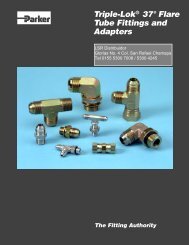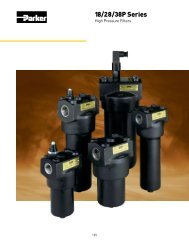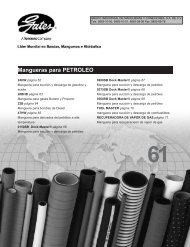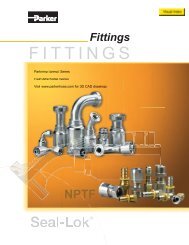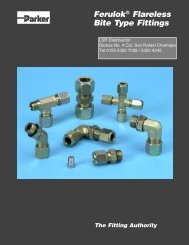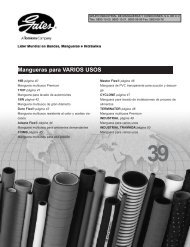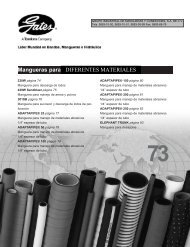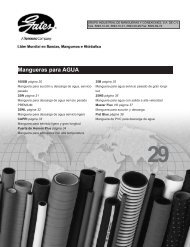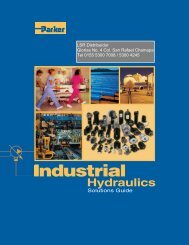Quick Coupling Products - LSR Distribuidor
Quick Coupling Products - LSR Distribuidor
Quick Coupling Products - LSR Distribuidor
- No tags were found...
You also want an ePaper? Increase the reach of your titles
YUMPU automatically turns print PDFs into web optimized ePapers that Google loves.
AppendicesSafety GuideSAFETY GUIDE FOR SELECTING AND USING QUICK ACTIONCOUPLINGS AND RELATED ACCESSORIESDANGER: Failure or improper selection or improper use of quick action couplings or related accessories can cause death, personalinjury and property damage. Possible consequences of failure or improper selection or improper use of quick action couplingsor related accessories include but are not limited to:• <strong>Coupling</strong>s or parts thrown off at high speed.• Dangerously whipping hose.• High velocity fluid discharge.• Contact with conveyed fluids that may be hot, cold,• Explosion or burning of the conveyed fluid.toxic, or otherwise injurious.• Contact with suddenly moving or falling objects that are • Sparking or explosion while paint or flammableto be held in position or moved by the conveyed fluid. liquid spraying.Before selecting or using any Parker quick action couplings or related accessories, it is important that you read and follow thefollowing instructions.1.1 Scope: This safety guide provides instructions for selecting and using(including installing connecting, disconnecting, and maintaining) quick actioncouplings and related accessories (including caps, plugs, blow guns, and twoway valves). This safety guide is a supplement to and is to be used with, thespecific Parker publications for the specific quick action couplings and relatedaccessories that are being considered for use.1.2 Fail-Safe: <strong>Quick</strong> action couplings or the hose they are attached to can failwithout warning for many reasons. Design all systems and equipment in a failsafemode, so that failure of the quick action coupling or hose will not endangerpersons or property.1.3 Distribution: Provide a copy of this safety guide to each person that isresponsible for selecting or using quick action coupling products. Do not selector use quick action couplings without thoroughly reading and understandingthis safety guide as well as the specific Parker publications for the productsconsidered or selected.1.4 User Responsibility: Due to the wide variety of operating conditions anduses for quick action couplings, Parker and its distributors do not represent orwarrant that any particular quick action coupling is suitable for any specific enduse system. This safety guide does not analyze all technical parameters thatmust be considered in selecting a product. The user, through its own analysisand testing, is solely responsible for:2.4 Size: Transmission of power by means of pressurized liquid varies withpressure and rate of flow. The size of the quick action couplings and othercomponents of the system must be adequate to keep pressure losses to aminimum and avoid damage due to heat generation or excessive fluid velocity.2.5 Pressurized Connect or Disconnect: If connecting or disconnectingunder pressure is a requirement, use only quick action couplings designed forthat purpose. The rated operating pressure of a quick action coupling may notbe the pressure at which it may be safely connected or disconnected.2.6 Environment: Care must be taken to ensure that quick action couplingsare either compatible with or protected from the environment (that is,surrounding conditions) to which they are exposed. Environmental conditionsincluding but not limited to ultraviolet radiation, ozone, moisture, water, saltwater, chemicals, and air pollutants can cause degradation and prematurefailure.2.7 Locking Means: Ball locking quick action couplings can unintentionallydisconnect if they are dragged over obstructions on the end of a hose or if thesleeve is bumped or moved enough to cause disconnect. Sleeves designedwith flanges to provide better gripping for oily or gloved hands are especiallysusceptible to accidental disconnect and should not be used where theseconditions exist. Sleeve lock or union (threaded) sleeve designs should beconsidered where there is a potential for accidental uncoupling.• Making the final selection of the quick action couplings.• Assuring that the user’s requirements are met and that the use presents nohealth or safety hazards.• Providing all appropriate health and safety warnings on the equipment onwhich the quick action couplings are used.1.5 Additional Questions: Call the appropriate Parker customer servicedepartment if you have any questions or require any additional information. Forthe telephone numbers of the appropriate customer service department, seethe Parker publication for the product being considered or used.2.0 QUICK ACTION COUPLING SELECTION INSTRUCTIONS2.1 Pressure: <strong>Quick</strong> action couplings selection must be made so that thepublished rated pressure of the coupling is equal to or greater than themaximum system pressure. Surge pressures in the system higher than therated pressure of the coupling will shorten the quick action coupling’s life. Donot confuse burst pressure or other pressure values with rated pressure anddo not use burst pressure or other pressure values for this purpose.2.2 Fluid Compatibility: <strong>Quick</strong> action couplings selection must assurecompatibility of the body and seal materials with the fluid media used. See thefluid compatibility chart in the Parker publication for the product beingconsidered or used.2.3 Temperature: Be certain that fluid and ambient temperatures, bothsteady and transient, do not exceed the limitations of the quick actioncouplings. Use caution and hand protection when connecting or disconnectingquick action couplings that are heated or cooled by the media they are conductingor by their environment.2.8 Mechanical Loads: External forces can significantly reduce quick actioncouplings’ life or cause failure. Mechanical loads which must be consideredinclude excessive tensile or side loads, and vibration. Unusual applicationsmay require special testing prior to quick action couplings selection.2.9 Specifications and Standards: When selecting quick action couplings,government, industry, and Parker specifications must be reviewed and followedas applicable.2.10 Vacuum: Not all quick action couplings are suitable or recommended forvacuum service. <strong>Quick</strong> action couplings used for vacuum applications must beselected to ensure that the quick actions couplings will withstand the vacuumand pressure of the system.2.11 Fire Resistant Fluids: Some fire resistant fluids require seals other thanthe standard nitrile used in many quick action couplings.2.12 Radiant Heat: <strong>Quick</strong> action couplings can be heated to destruction orloss of sealability without contact by such nearby items as hot manifolds ormolten metal. The same heat source may then initiate a fire. This can occurdespite the presence of cool air around the quick action couplings.2.13 Welding and Brazing: Heating of plated parts, including quick actioncouplings and port adapters, above 450°F (232°C) such as during welding,brazing, or soldering may emit deadly gases and may cause coupling sealdamage.AppendicesII-1Parker Hannifin Corporation<strong>Quick</strong> <strong>Coupling</strong> DivisionMinneapolis, MN 55427



